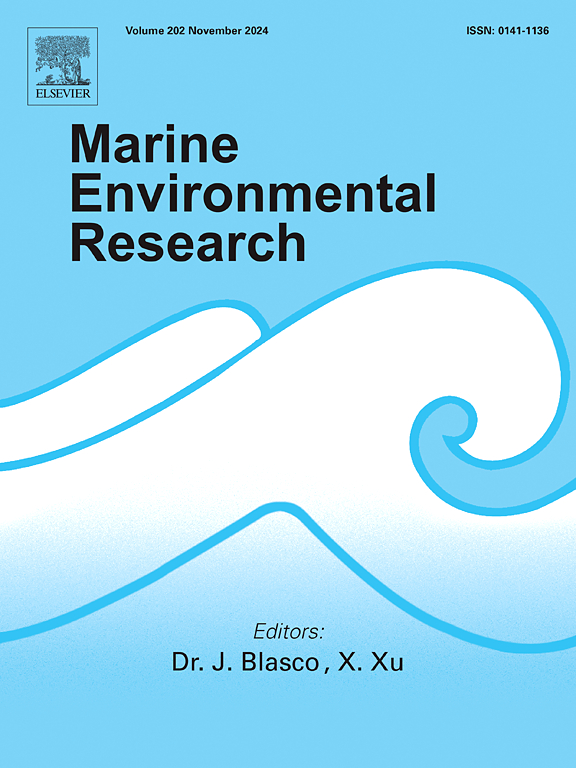巴西赤道边缘河口浮游植物功能群动态和碳浓度
IF 3.2
3区 环境科学与生态学
Q2 ENVIRONMENTAL SCIENCES
引用次数: 0
摘要
浮游植物功能群的研究对于了解肥厚环境的生态动态至关重要。阿尼尔河河口(ARE)位于巴西北部海岸的巴西赤道边缘,受来自南大西洋的半日潮和阿尼尔河河水的影响,这是一个高度城市化和有许多人为压力的地区。在2022年至2023年期间,在旱季和雨季,在两个部门(SI -富营养化;SII -肥厚化)的8个点进行了6次抽样活动。基于功能性状和物种密度矩阵,采用FEve、FDiv和FDis指数评价群落功能多样性。ARE浮游植物群落包括6个类群234个类群,其中硅藻数量最多(57.69%),其次是蓝藻(14%)和肌虫(8.5%)。共鉴定出25个雷诺官能团(fg),受盐度和pH值影响显著,其中M和X1基团最具代表性。在不同的季节和不同的区系中,SII在雨季记录了25个类群中85%的物种,而SI在23个类群中记录了76%的物种。功能性状允许形成三个主要类群:(I)来自肥厚环境(<20 μm)的物种,以蓝藻和绿藻为主;(II)富营养化环境中的海洋硅藻(>20 μm);(III)河口水域的种类,包括裸藻和绿藻(>20 μm)。该研究强调了受城市化和富营养化影响的河口浮游植物功能组成与环境条件的关系。本文章由计算机程序翻译,如有差异,请以英文原文为准。

Dynamics of phytoplankton functional groups and carbon concentrations in an estuary on the Brazilian equatorial margin
The study of phytoplankton functional groups is essential for understanding the ecological dynamics of hypertrophic environments. The Anil River Estuary (ARE) is located on the Brazilian equatorial margin on the northern coast of Brazil and is influenced by semidiurnal macrotides from the South Atlantic and the river waters of the Anil River, which are highly urbanized and have many anthropic pressures. Between 2022 and 2023, six sampling campaigns were conducted at eight points across two sectors (SI - eutrophic; SII - hypertrophic) during the dry and rainy seasons. The functional diversity (FD) of the community was assessed using indices FEve, FDiv, and FDis, based on a matrix of functional traits and species density. The ARE phytoplankton community comprised 234taxa in six taxonomic groups, with diatoms being the most abundant (57.69 %), followed by Cyanobacteria (14 %) and Myozoa (8.5 %). Twenty-five Reynolds functional groups (FGs) were identified, significantly influenced by salinity and pH, with groups M and X1 being the most representative. The FGs varied between sectors and seasons, with SII recording 85 % of the species within 25 groups during the rainy season, while SI showed 76 % in 23 groups. Functional traits allowed the formation of three major groups: (I) species from hypertrophic environments (<20 μm), dominated by cyanobacteria and charophytes; (II) marine diatoms from eutrophic environments (>20 μm); and (III) species from estuarine waters, including euglenophytes and chlorophytes (>20 μm). The study highlights the relationship between the functional composition of phytoplankton and environmental conditions in an estuary impacted by urbanization and eutrophication.
求助全文
通过发布文献求助,成功后即可免费获取论文全文。
去求助
来源期刊

Marine environmental research
环境科学-毒理学
CiteScore
5.90
自引率
3.00%
发文量
217
审稿时长
46 days
期刊介绍:
Marine Environmental Research publishes original research papers on chemical, physical, and biological interactions in the oceans and coastal waters. The journal serves as a forum for new information on biology, chemistry, and toxicology and syntheses that advance understanding of marine environmental processes.
Submission of multidisciplinary studies is encouraged. Studies that utilize experimental approaches to clarify the roles of anthropogenic and natural causes of changes in marine ecosystems are especially welcome, as are those studies that represent new developments of a theoretical or conceptual aspect of marine science. All papers published in this journal are reviewed by qualified peers prior to acceptance and publication. Examples of topics considered to be appropriate for the journal include, but are not limited to, the following:
– The extent, persistence, and consequences of change and the recovery from such change in natural marine systems
– The biochemical, physiological, and ecological consequences of contaminants to marine organisms and ecosystems
– The biogeochemistry of naturally occurring and anthropogenic substances
– Models that describe and predict the above processes
– Monitoring studies, to the extent that their results provide new information on functional processes
– Methodological papers describing improved quantitative techniques for the marine sciences.
 求助内容:
求助内容: 应助结果提醒方式:
应助结果提醒方式:


